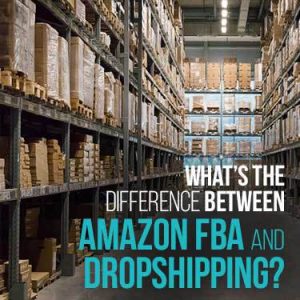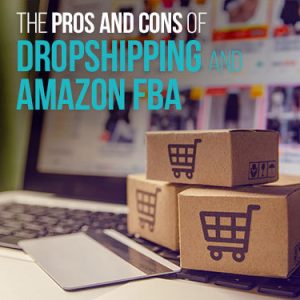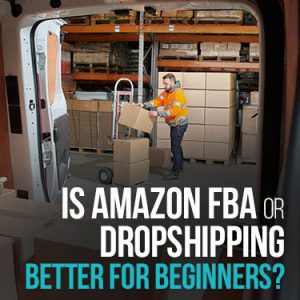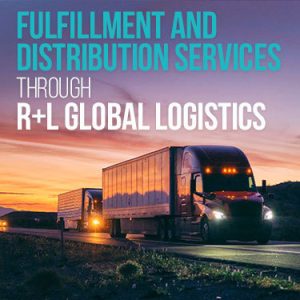If you’re looking to start an eCommerce business, you might be feeling a bit overwhelmed at the variety of different options available for selling online. Even if you’ve narrowed down your options to Amazon FBA or dropshipping, it can still be tough to choose between those two. Both options have their fair share of benefits and drawbacks, but they are ultimately two of the best options for online sellers.
Both Amazon FBA and dropshipping are great options for entrepreneurs looking to break into eCommerce. When choosing between them, you’ll need to consider profit margins, shipping times, investments, risk, and many other factors. Ultimately, you will need to decide which factors are the most important to you.
In our guide below, we explore the differences and similarities between the two and also provide you with a third option that many entrepreneurs are now utilizing.
What’s the Difference Between Amazon FBA and Dropshipping?
Before we move on, it’s important for you to understand what Amazon FBA and dropshipping is, and how those two options differ from one another. Though they may sound similar in theory, there are many factors that set them apart.
Dropshipping is the process of selling goods on behalf of another store, supplier, or manufacturer. If you were to start dropshipping, you would take up the task of marketing and selling the supplier’s goods. When you make a sale, the manufacturer gets notified and ships the order for you. You never have to see the products, and you don’t need to purchase any stock up-front.
FBA stands for “Fulfillment By Amazon,” and it is the process by which your stock is stored in an Amazon warehouse and fulfilled by Amazon employees. Because of the nature of the program, you DO need to purchase stock up-front AND pay for storage, but your products would then be eligible for Prime Shipping and listings on Amazon (in addition to your website). Like with dropshipping, however, you wouldn’t need to worry about fulfilling orders yourself.
The biggest differences between the two options relate to product inventory. With Amazon FBA, you need to provide the warehouses with products, which means several things. You would need to invest more money in the beginning to get your business off the ground, and you will also need to keep track of that inventory so you know when to order more. You wouldn’t need to do any of that with dropshipping. Aside from that, the two options function similarly.
The Pros and Cons of Dropshipping and Amazon FBA
Both Amazon FBA and dropshipping are great options for starting an eCommerce store, but one might be better for your particular business. Depending on your products, starting funds, amount of free time, and more, you might end up benefiting from one option more than the other.
To get a good idea of which option is better for you, you’ll need to weigh the pros and cons of both dropshipping and Amazon FBA and compare them to each other.
Pros of Dropshipping
Dropshipping is often touted as the number one way to make money online by eCommerce gurus (and with good reason), but you shouldn’t just take their word for it. Examining the perks that make it so great is the first step towards making an educated decision regarding your business.
The biggest benefits of choosing dropshipping over Amazon FBA are:
- Low risk: Because you don’t need to purchase any stock, create a new product, or deal with fulfillment, you have very little to lose.
- Low investment: Starting a dropshipping business requires very little upfront investment, so you can get started even if you don’t have a lot of money to start.
- Customizable: There are countless different suppliers that you could source your products from, and each one is going to have slightly different contracts. You can pick and choose who you want to work with, what you want to sell, and many other factors of your business. You can even exercise complete creative control over your website by making a Shopify store or WordPress site. Ultimately, you are in control.
- Customer contacts: If you start a dropshipping business, and then later decide you want to change suppliers (or even start manufacturing your own products), you will be able to keep all of your customer contacts. If you have an email list, that belongs to you, not your supplier.
- Low effort: Managing a dropshipping business doesn’t require much effort and time, especially when you compare it to traditional business models. Since the responsibilities of shipping the product, stocking the shelves, and managing distribution fall on the supplier, you can use your time for other things. This makes dropshipping a great option for a side business.
- No inventory: Without having to worry about keeping stock and replenishing inventory, your job will be a lot less stressful and time-consuming.
With all that said, running a dropshipping store isn’t all smooth sailing. There are some drawbacks and difficulties associated with it, otherwise, everyone would be doing it!
Looking for a solution to store and ship your products seamlessly? Let R+L Global Logistics be your fulfillment and distribution partner.
Cons of Dropshipping
As with any business model, you need to be aware of the negative aspects before you commit to it. Here are the less-than-glamorous aspects of dropshipping that you should know about:
- Slow shipping: Because your products would be shipping straight from the supplier (which may or may not be overseas) to the customer, shipping can often take a long time. If you’re concerned about this, you can try to find a domestic supplier, or communicate with your supplier about shipping options.
- High competition: One of the biggest issues with dropshipping is how the market has been flooded with products that all look the same, but are branded differently. You can’t know for sure how many other entrepreneurs your supplier is supplying, but you can bet you aren’t the only one. This is especially true if you found your supplier on Alibaba, which is one of the most popular eCommerce supplier networks on the web.
- Small customer base: With dropshipping, you are limited by your marketing abilities. You will never be able to reach as many customers as you would be able to with Amazon, and it may take a lot of effort to get your website in the spotlight.
- Customer service issues: Since your products would be shipping straight from the manufacturer to the customer, you can’t do any quality control. When something goes wrong or a customer isn’t satisfied, it can be an ordeal to get the situation settled. You may end up with more unhappy customers, and there’s very little you can do about it.
- Lower profits: Since you aren’t buying inventory, you can’t save money by buying stock in bulk, and you can’t sell products for much more than they’re worth. Depending on your products, you may only make a few cents to a few dollars in profit with every sale.
- Hard to build a brand: Many consumers are loyal to big brands, and it may be difficult to build a trustworthy name for yourself. If you’re a small company without any brand recognition, it’s going to be much harder to drive traffic to your sales page.
If those drawbacks sound manageable to you, dropshipping might be the way to go! However, you should still consider all your options before settling on a decision.
Pros of Amazon FBA
Amazon is a glamorous option for online entrepreneurs, and you’ve no doubt been tempted by all their flashy perks. Here’s a run-down of some of the best benefits of choosing Amazon FBA over dropshipping:
- Fast shipping: Thanks to Amazon’s developed distribution network, your customers could order a package and receive it as soon as the same day they ordered it (though it’s usually between 1-2 days).
- Listing on Amazon: If you’re part of the FBA program, you can list your products for sale on Amazon and on your own personal website. This widens your potential audience significantly.
- Free shipping: If your inventory is being fulfilled by Amazon, that would make your products eligible for free shipping for customers who buy through Amazon’s Prime program. This would come at no extra cost to you, but it’s a nice perk for your customers.
- Huge customer base: Because of the option of listing your products on Amazon, you have the potential to reach an enormous customer base. In fact, Amazon makes up 49% of the US eCommerce market, so being able to list your products on their site is hugely advantageous.
- High customer satisfaction: Amazon is a leader in putting customers first. Their easy returns process, fast shipping, and commitment to quality mean that you’ll end up with more happy customers.
- Larger profits: Since Amazon makes it easier to complete a sale and get your product noticed, you can spend less on marketing. You can also purchase goods in bulk to get bulk discounts, which adds up to higher profits and more money in your pocket.
- Brand recognition and association: If your product is listed on and fulfilled by Amazon, consumers are a lot more likely to trust you. By working with Amazon, you can take advantage of that positive brand association.
- Easy returns: If a customer isn’t happy with their purchase, Amazon makes it very easy to return packages with a variety of different options. That means your customers will be satisfied, and you’ll be spared the headache of dealing with unhappy customers and complicated reverse logistics.
- Easy to scale to international audiences: Amazon ships to many different countries, allowing you to offer your products to an international audience without having to deal with customs and hefty shipping fees.
There’s no doubt about it: Amazon is a tempting choice. However, like with dropshipping, it’s not without its flaws.
Cons of Amazon FBA
It’s hard to look past all the great benefits of Amazon, but it has its fair share of negatives as well. Amazon FBA isn’t a perfect solution for eCommerce fulfillment. Here are some of the biggest drawbacks of the FBA program:
- High risk: Working with Amazon means you need to invest in products to sell ahead of time, and you’ll also need to pay a fixed rate and storage fees for using their services. That means if your product doesn’t sell for some reason, you could end up losing a lot of money.
- High investment: In order to start selling on Amazon, you need a fair amount of funding to even get your store established.
- Not customizable: When you become part of the FBA program, you forfeit a lot of control over your business. Amazon could change the terms, remove your store, or even alter your listings—all without consulting you first. You have to agree to their terms exactly as they are, and you can’t negotiate anything.
- Really high competition: A lot of people are selling goods on Amazon, and many of them are probably getting their goods from the same suppliers. If you want to stand a chance, you need your product to be unique, otherwise, your store will look exactly like everyone else’s.
- No direct contact with customers: If you set up your store with Amazon, and then later decide to stop using their program, then you lose all contact with any of the customers who purchased your goods on Amazon. Those are Amazon’s customers, not yours, and you don’t maintain any contact with them once you leave the program.
- Inventory: Since you need to have products to store in Amazon’s warehouses, you will need to worry about inventory. That includes keeping track of inventory, ordering restocks, and dealing with unsold products that could build up in the warehouse and cost you money.
- Storage fees: Unlike with dropshipping, you will have to pay to store your goods in an Amazon warehouse. As mentioned above, this can get very expensive if you have large amounts of unsold inventory piling up over time.
Now that you know all the major pros and cons of Amazon FBA and dropshipping, you can make a more educated decision about which one is right for you.
Is Amazon FBA or Dropshipping Better for Beginners?
If you’re just getting started in the world of eCommerce and you don’t have a lot of experience with running a business, then you’ll probably want to pick dropshipping over Amazon FBA.
Dropshipping is the most beginner-friendly option.
That’s the quick answer, but here’s an explanation for why that’s the case. It all boils down to the risks involved. If you’ve never sold anything online before, and you have little to no experience with running a business, you should minimize your risk as much as possible. With dropshipping, you have much less to lose.
Without having to worry about inventory, you can more safely experiment with which products sell well, how to maximize profits, and what the best marketing techniques are. Once you get a business established and you’re more confident in your abilities, you can move on to a different business model if you want—or not! Dropshipping is a great option for businesses of any size, and you can continue to make a profit as your business scales up.
An Alternative to Amazon FBA and Dropshipping
If you read through the pros and cons of both Amazon FBA and dropshipping, and you aren’t sure you want to use either option, you don’t have to worry. There’s another option that can offer you the customization of dropshipping with the quality and speed of Amazon: a Third Party Logistics Company (3PL).
It might take you some extra effort to track down a good 3PL, but that can truly offer you the best of both worlds. Like with Amazon, you would need to acquire your own stock to store in the 3PL warehouses, but unlike Amazon, you can have full customization over packaging, kitting and assembly, packaging inserts, shipping options, and much more. When you work with Amazon, they call the shots, but a 3PL works for you.
If you aren’t happy with the options provided by dropshipping and Amazon FBA, then you should consider working with a 3PL instead.
Fulfillment and Distribution Services through R+L Global Logistics
If you’re tired of comparing the disadvantages of Amazon FBA vs dropshipping, then it may be time to consider the better option.
R+L Global Logistics is a leader in the 3PL industry, with a focus on quality, customer service, and accessibility. We pride ourselves on our ability to serve any sized company in any industry, and we never compromise on the service we provide. If you want a widespread distribution partner with locations all across the US, but also the values and service of a decades-old family-owned business, then look no further!
At R+L Global Logistics, we offer a wide variety of value-added services to take your distribution to the next level. These services include:
In addition to that, we can provide multilingual staff members to communicate with you on your terms and to facilitate the most effective communication possible. When you work with us, you become part of the R+L family.
If you want more information on the services we provide, you can reach out to us at (866) 989-3082. Our friendly customer service representatives are always happy to help.
If you’re interested in working with us, you can request a free fulfillment quote right on our website.
Looking for a solution to store and ship your products seamlessly? Let R+L Global Logistics be your fulfillment and distribution partner.

 Copy URL to Clipboard
Copy URL to Clipboard




